What to avoid in an off road caravan
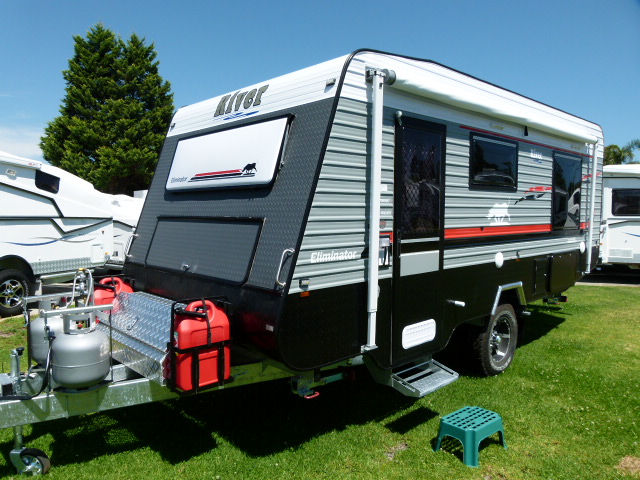
When you’re out and about looking for a new or pre loved caravan, everyone is full of advice about the features you have to have but no one seems to ever say anything about what to avoid. I find this rather amazing as some of the items listed below can really make your caravan experience, particularly off road, quite unpleasant and perhaps even a bit dangerous.
Now most of these are primarily related to off road caravans however I would consider some of these as things to avoid in a caravan used in normal road conditions as well. Australia’s roads are not like they are in the USA or Europe. They are rough, poorly maintained in many areas and, in places around the tropical north of the country, can be prone to flood damage.
Not everyone will agree with my recommendations and that’s fine. We can’t all agree on everything. But I have done my fair share of outback travelling and have experienced some of the issues identified here along the way.
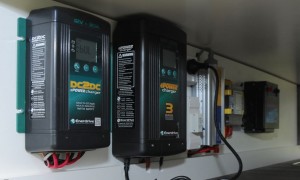 Vulnerable Electrics
Vulnerable Electrics
It constantly amazes me the way many caravan manufacturers install vital electrical components and their associated wiring in places where they can be easily damaged. As you can see in the example here, the manufacturer has mounted the battery charger, solar controller and emergency breakaway control unit all inside the tunnel boot where they can be knocked and damaged by stored items. Some of the 240v power cords are just left lying loose. Apart from compromising your valuable storage space, this can potentially lead to damaged 240v wiring or electrical components that could fail or, worse, present a fire risk. I like to see electrical systems mounted away in their own storage area such as under the seats or mounted high in a front boot out of the way of other items.
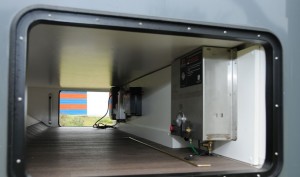 Non water proof storage
Non water proof storage
While we on the subject of storage areas, I cannot understand the logic behind lining these major outside storage areas, such as the tunnel boot or front boot, with wood or vinyl panelling. These materials are not waterproof and when you consider the sort of stuff you’re likely to throw in these areas, you really want them to be waterproof or at least moisture resistant. Lining these areas with galvanised sheeting ensures nothing is going to rot or rust if it gets wet. It also protects the lining and framing of the van from water and moisture ingress. Cleaning out these areas is also very easy.
Chassis mounted External battery boxes
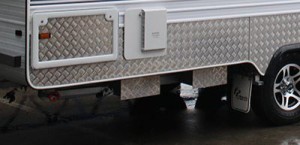 I was always a little sceptical whenever I saw manufacturers mounting external battery boxes on the chassis of their caravans. They always looked a little vulnerable to me but I had been assured that they were strong enough to withstand any conditions. In recent times I’ve seen cases of these boxes being dislodged or damaged by being showered with gravel and the constant vibrations of miles of corrugated roads. Again, I would prefer the batteries are stored in their own area away from the outside elements. Under the seats with all the other electrical equipment would seem logical as long as the space is well ventilated. You see them mounted in the front or tunnel boots, and sometimes in the under bed storage areas, but again they are vulnerable to damage from other items stored in those areas however these areas are preferable to the chassis mounted boxes.
I was always a little sceptical whenever I saw manufacturers mounting external battery boxes on the chassis of their caravans. They always looked a little vulnerable to me but I had been assured that they were strong enough to withstand any conditions. In recent times I’ve seen cases of these boxes being dislodged or damaged by being showered with gravel and the constant vibrations of miles of corrugated roads. Again, I would prefer the batteries are stored in their own area away from the outside elements. Under the seats with all the other electrical equipment would seem logical as long as the space is well ventilated. You see them mounted in the front or tunnel boots, and sometimes in the under bed storage areas, but again they are vulnerable to damage from other items stored in those areas however these areas are preferable to the chassis mounted boxes.
Short draw bars
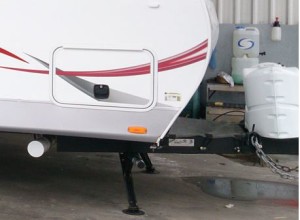 When I say short drawbars, I’m referring to how far along the main chassis the drawbars extend towards the axels. Good off road caravans have these extend right to the axels or close to them. Some mot so good off road vans barely make it past the front boot. I’ve never witnessed it myself but I have heard many stories of these shorter A frames cracking and failing at the point they contact the main chassis. I believe this is due to the weight on the drawbar and in the front section of the van creating a pivot point where the A frame joins the chassis. Have a good look at the A frame and ensure it extends all the way back to the axels as far as possible.
When I say short drawbars, I’m referring to how far along the main chassis the drawbars extend towards the axels. Good off road caravans have these extend right to the axels or close to them. Some mot so good off road vans barely make it past the front boot. I’ve never witnessed it myself but I have heard many stories of these shorter A frames cracking and failing at the point they contact the main chassis. I believe this is due to the weight on the drawbar and in the front section of the van creating a pivot point where the A frame joins the chassis. Have a good look at the A frame and ensure it extends all the way back to the axels as far as possible.
Excessive or poor use of sealants
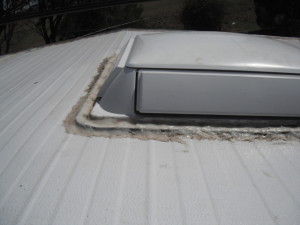 It sometimes is not very obvious how well sealed your caravan is just by looking at it, but it is incredible how may near new vans end up with severe wood rot as a result of poor sealing in the roof and around the external fixtures. Often by the time you find out the job hasn’t been done properly, it’s too late and you’re up for an expensive repair bill and a real shake to your confidence in your caravan. One way to tell if due care and attention has been paid to the sealing process is to have a look at the roof of the van. If it looks like someone has gone nuts with the silicon sealant in the vain hope that they have effectively waterproofed the van, chances are they had no idea what they were doing and have made a mess of the job. Proper sealants do not need to be applied in such a manner and the roof should look as neat and well-constructed as the rest of the van. Don’t be afraid to get up and have a look at the roof.
It sometimes is not very obvious how well sealed your caravan is just by looking at it, but it is incredible how may near new vans end up with severe wood rot as a result of poor sealing in the roof and around the external fixtures. Often by the time you find out the job hasn’t been done properly, it’s too late and you’re up for an expensive repair bill and a real shake to your confidence in your caravan. One way to tell if due care and attention has been paid to the sealing process is to have a look at the roof of the van. If it looks like someone has gone nuts with the silicon sealant in the vain hope that they have effectively waterproofed the van, chances are they had no idea what they were doing and have made a mess of the job. Proper sealants do not need to be applied in such a manner and the roof should look as neat and well-constructed as the rest of the van. Don’t be afraid to get up and have a look at the roof.
Painted or powder coated chassis
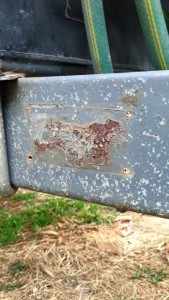 While it may not be a big issue for vans and campers that stick mainly to the blacktop, it can be a huge issue for off road vans. The underside of your trailer gets blasted with stones when you travel along miles of gravel roads and a painted or powder coated chassis will look like it’s been sandblasted down to the bare metal. If left unattended, this will soon rust causing all sorts of problems. Galvanised chassis do not suffer this issue and will survive years of constant dirt roads and never rust. But make sure the process has been done correctly. Hot dipped galvanised is the way to go and the better known chassis manufacturers all use this process.
While it may not be a big issue for vans and campers that stick mainly to the blacktop, it can be a huge issue for off road vans. The underside of your trailer gets blasted with stones when you travel along miles of gravel roads and a painted or powder coated chassis will look like it’s been sandblasted down to the bare metal. If left unattended, this will soon rust causing all sorts of problems. Galvanised chassis do not suffer this issue and will survive years of constant dirt roads and never rust. But make sure the process has been done correctly. Hot dipped galvanised is the way to go and the better known chassis manufacturers all use this process.
Exposed wiring and plumbing
When looking at caravans and campers, get underneath and have a good look at how the electrical wiring and plumbing lines have been run through the chassis.
 Some are left exposed and are vulnerable to damage from stones and other hazards. All these components should be tucked away as close to the upper chassis rails as possible for added protection or encased in high quality conduit. Plastic drain pipes are particularly vulnerable to stone damage so wrapping them up in foam tubing can help prevent unwanted damage.
Some are left exposed and are vulnerable to damage from stones and other hazards. All these components should be tucked away as close to the upper chassis rails as possible for added protection or encased in high quality conduit. Plastic drain pipes are particularly vulnerable to stone damage so wrapping them up in foam tubing can help prevent unwanted damage.
Exposed Plywood flooring
Pretty much all caravans will have a plywood floor as their base but these should be protected by a galvanised sheet lining or other suitable material. Stones, water and dust can cause all sorts of damage to exposed wood. While you’re underneath the van checking out the plumbing and wiring, have a look to see if anything is protecting the plywood floor.
Excessive protruding accessories
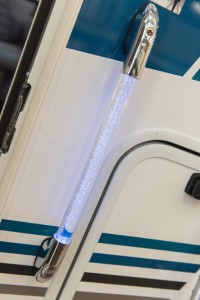 I just love the way many supposed off road caravan manufacturers place items such as plugs, grab handles and other fixtures on the outside of the van where they are vulnerable to being damaged or torn off in off road situations. Some things cannot be helped such as the awning and 240v inlet plugs but even then they can be properly mounted using strong hardware or located in such a way as to minimise the risk. My particular favourite is what I like to refer to as the strip joint illuminated grab handle you see on many vans. Apart from the real tacky look (in my opinion anyway) they are very flimsy and would break away with the slightest bump. Certainly not what you want on an off road van.
I just love the way many supposed off road caravan manufacturers place items such as plugs, grab handles and other fixtures on the outside of the van where they are vulnerable to being damaged or torn off in off road situations. Some things cannot be helped such as the awning and 240v inlet plugs but even then they can be properly mounted using strong hardware or located in such a way as to minimise the risk. My particular favourite is what I like to refer to as the strip joint illuminated grab handle you see on many vans. Apart from the real tacky look (in my opinion anyway) they are very flimsy and would break away with the slightest bump. Certainly not what you want on an off road van.
Mud tires
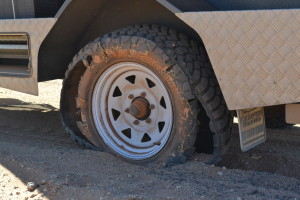 I personally fell for this trick. Mud tires look great on a 4wd but they look particularly awesome on a caravan or camper. The give the impression of real hard core off road ability. Trouble is these tires are pretty much useless in dirt or gravel road conditions. Mud tires are for gaining traction in the mud. The large spaces between the tread blocks allow the tire to self-clean as you drive along. The issue with off road vans and campers is there is no need for gaining traction in the mud. They just track along behind your 4wd. In gravel or dirt roads, the voids in the tread are vulnerable to stone damage. In fact they present a nice large target for a sharp stone to puncture the tire. Make sure the tires fitted to your caravan or camper are good old all-terrain light truck tyres. These will last much longer and resist punctures much better than muddies in the long run
I personally fell for this trick. Mud tires look great on a 4wd but they look particularly awesome on a caravan or camper. The give the impression of real hard core off road ability. Trouble is these tires are pretty much useless in dirt or gravel road conditions. Mud tires are for gaining traction in the mud. The large spaces between the tread blocks allow the tire to self-clean as you drive along. The issue with off road vans and campers is there is no need for gaining traction in the mud. They just track along behind your 4wd. In gravel or dirt roads, the voids in the tread are vulnerable to stone damage. In fact they present a nice large target for a sharp stone to puncture the tire. Make sure the tires fitted to your caravan or camper are good old all-terrain light truck tyres. These will last much longer and resist punctures much better than muddies in the long run
Ineffective stone guards
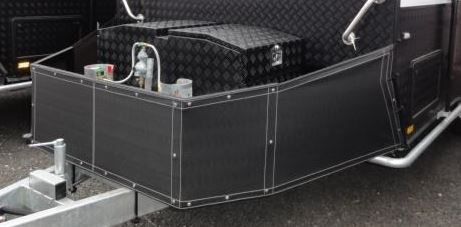 Any off road van or camper will have a stone guard fitted to the front drawbar. It’s there to prevent stones being flung into the front of the van and ricocheting onto the rear of the tow vehicle where they can shatter the rear windscreen. Problem is many of these stone guards are made in such a way as to almost facilitate this to happen. They are mounted almost vertically instead of being angled down towards the ground. Also the material is pulled so taut it acts like a trampoline and slingshots the stones onto the back of the tow vehicle with greater velocity. Ensure the stone guard is actually designed properly to avoid this happening.
Any off road van or camper will have a stone guard fitted to the front drawbar. It’s there to prevent stones being flung into the front of the van and ricocheting onto the rear of the tow vehicle where they can shatter the rear windscreen. Problem is many of these stone guards are made in such a way as to almost facilitate this to happen. They are mounted almost vertically instead of being angled down towards the ground. Also the material is pulled so taut it acts like a trampoline and slingshots the stones onto the back of the tow vehicle with greater velocity. Ensure the stone guard is actually designed properly to avoid this happening.
As always this is by no means an exhaustive list but it is a good place to start to get ideas about what to look out for and avoid when purchasing an off road van. If you see a van you like and it has one of these flaws, perhaps ask the seller if they will modify it for you to be more off road friendly. If not, consider looking elsewhere.
Safe Travels.

